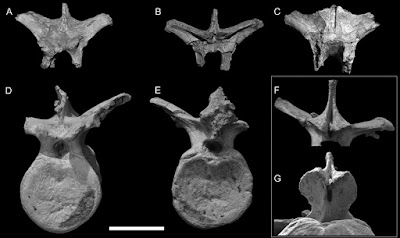Nuevo registro de ornitópodos provenientes de la Formación Plottier, Rincón de los Sauces, Neuquén
0 comentarios Publicado por Leonardo Filippi en 8:32
Penélope
Cruzado-Caballeroa, Leonardo S. Filippi, Ariel H. Méndez, Alberto C. Garrido
and Rubén D. Juárez Valieri
Ornithopods are the
least known dinosaurs within the Upper Cretaceous record of Argentina. For this
rea-son every new record is very important to know their evolution in South
America. Here, we describe a new remain of an indeterminate ornithopod recovered
in the Petrobrasaurus quarry of the
Puesto Hernández area, northeastern Neuquén province (Argentina), late
Coniacian–early Santonian in age. MAU-Pv-PH-458 is the northernmost bone record
of an ornithopod in Argentina. This is a fragmentary neural arch fromthe middle
section of the dorsal series of similar size to Macrogryphosaurus gondwanicus. MAU-Pv-PH-458 has typical ornithopod
characters such as a lateromedial narrow neural spine and transverse
processes dorsoposteriorly to posteriorly oriented. It shares with Macrogryphosaurus the presence of a deep
cannel between the bases of the postzygapophysis, which is a continuation of
the channel that separates the postzygapophyses in posterior view. MAU-Pv-PH-458
increases the ornithopod record from the Plottier Formation.
Cruzado-Caballero, P.,
et al., New record of ornithopod dinosaur from the Plottier Formation (Upper
Cretaceous), Patagonia, Argentina. Annales de Paléontologie (2016), http://dx.doi.org/10.1016/j.annpal.2016.02.003
New rebbachisaurid cranial remains (Sauropoda, Diplodocoidea) from the Cretaceous of Patagonia
0 comentarios Publicado por Leonardo Filippi en 15:32
Ariana
Paulina Carabajal, Juan I. Canale, and Alejandro Haluza
Report a new
rebbachisaurid material recovered from the Candeleros Formation (Cenomanian) of
northwest Patagonia, Argentina. The cranial remains consist of a partial
braincase and a right quadrate. Fractures in the braincase exposed the
endocranial cavity, allowing the first study of the brain and inner ear
morphologies of a South American rebbachisaurid. The braincase and cranial
endocast both exhibit traits similar to those observed in the Cretaceous
rebbachisaurs Nigersaurus from Africa and Limaysaurus from Argentina, although
in terms of osteology, the South American taxa are highly similar. The endocast
is more similar to that of Nigersaurus than to those of Diplodocus and
Camarasaurus, suggesting some probable rebbachisaurid features such as the
noteworthy presence of the flocculus. The overall morphology of the quadrate
shows similarities with Limaysaurus and Nigersaurus. However, differences such
as the broader posterior fossa and the shape and orientation of the head and
the pterygoid process indicate that the new specimen could represent a distinct
taxon.
Ariana Paulina
Carabajal, Juan I. Canale & Alejandro Haluza (2016): New rebbachisaurid
cranial remains (Sauropoda, Diplodocoidea) from the Cretaceous of Patagonia, Argentina,
and the first endocranial description for a South American representative of
the clade, Journal of Vertebrate Paleontology, DOI:
10.1080/02724634.2016.1167067
The skull of the titanosaur Tapuiasaurus macedoi, from the Lower Cretaceous of Brazil
0 comentarios Publicado por Leonardo Filippi en 8:25
Jeffrey
A. Wilson, Diego Pol, Alberto B. Carvalho & Hussam Zaher
Although Titanosauria
is the most diverse and late-surviving sauropod lineage, cranial elements are
known for just over 24 of its 70+ genera – the vast majority of which are
fairly fragmentary and restricted to the Late Cretaceous. Only three complete
titanosaur skulls have been described to date; two of these are from the latest
Cretaceous (Nemegtosaurus, Rapetosaurus), and the third, Tapuiasaurus, is from
the Early Cretaceous (Aptian). In this contribution, we build on the initial
treatment of the taxon by providing a complete description of the cranial
elements that benefits from additional preparation and computed tomography
imaging. We identify six additional features diagnosing Tapuiasaurus macedoi,
including a jugal with an elongate lacrimal process forming much of the
posteroventral border of the antorbital fenestra, a lateral temporal fenestra
divided by a second squamosal–postorbital contact, and upper jaw teeth with
labial wear facets. We directed the new morphological data in Tapuiasaurus as
well as other observations towards a re-analysis of its phylogenetic position
within Titanosauria. Our analysis yielded 34 most parsimonious trees, most of
which recovered Tapuiasaurus in a basal position adjacent to the Early
Cretaceous taxa Malawisaurus and Tangvayosaurus, but two trees recovered it
within Late Cretaceous nemegtosaurids. We explored the effects of missing data
and missing stratigraphic ranges on our results, concluding that (1) when
missing data levels are high, resolution of even small amounts of that missing
data can have dramatic effects on topology, (2) taxa that are mostly scored for
characters that cannot be scored in other taxa may be topologically unstable
and (3) there were several suboptimal trees that had greatly improved
stratigraphic fit with relatively little compromise in terms of tree length.
Jeffrey A. Wilson,
Diego Pol, Alberto B. Carvalho and
Hussam Zaher (2016) The skull of the titanosaur Tapuiasaurus macedoi
(Dinosauria: Sauropoda), a basal titanosaur from the Lower Cretaceous of Brazil.
Zoological Journal of the Linnean Society
DOI: 10.1111/zoj.12420
;;
Subscribe to:
Entradas (Atom)





